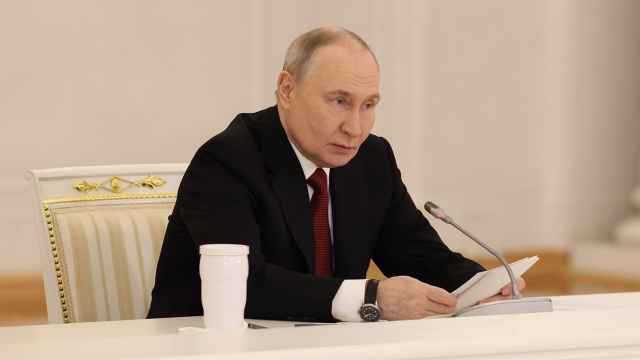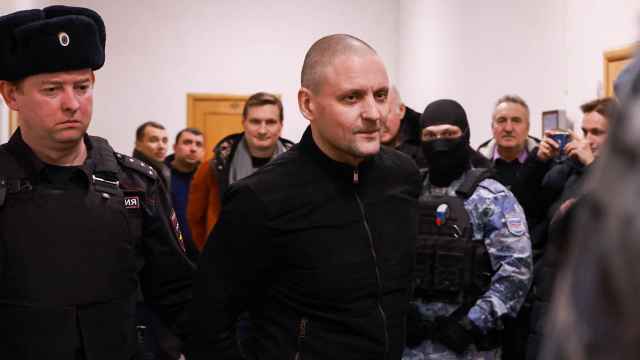Russia's attempts to wean itself off its chronic dependence on natural resources have failed to deliver tangible results, a study by the European Bank for Reconstruction and Development released Friday shows.
The 96-page report, titled "Diversifying Russia," makes sober reading for the government of President Vladimir Putin.
Russia, the world's largest oil and gas producer, has in recent years launched one initiative after another aimed at reducing its overreliance on commodities by promoting alternative sectors.
But none of this burst of activity is having any visible impact on the overall economic structure of Russia's $1.9 trillion economy, the report says.
"The basic point here is that for all the efforts and for all the talk, it hasn't improved," said Eric Berglof, chief economist at the EBRD. "They haven't managed, in the end, to make a dent into the natural-resource dependence."
The London-based development bank was set up to aid post-Communist economic transition.
High reliance on exports of commodities can be a curse because it makes an economy more vulnerable to fickle international prices and because these sectors have limited long-term growth potential.
The EBRD's analysis suggests that, if anything, Russia's commodity dependence has only increased since Putin first became president in 2000.
Oil and gas now account for about two-thirds of Russia's exports by value, up from 40 to 50 percent in the late 1990s.
When semiprocessed goods such as metals and chemicals are added, commodities account for about 90 percent of exports, a share that has budged little in price-adjusted terms.
In other ways, too, Russia's economy remains poorly diversified, with little evidence of improvement.
Small and medium-sized businesses, which produce almost 40 percent of gross domestic product in the European Union, contribute only about 15 percent of Russia's. Midsized firms, a driver of innovation elsewhere, are conspicuously lacking.
"That's not the structure you see in a well-developed and well-diversified economy," Berglof said in an interview.
Top-down Modernisation
The EBRD's conclusions come despite a series of high-profile initiatives — often dubbed state-led or top-down modernization — to promote new sectors outside the commodity industries.
A state-backed venture fund launched in 2006 was meant to kick-start the fledgling venture capital industry. And Rusnano, a state corporation created in 2007, has plowed billions of dollars into nanotechnology and other high-tech projects.
Russia also has high hopes for Skolkovo, a technology park outside Moscow dubbed Russia's answer to Silicon Valley, and the Russian Direct Investment Fund, a state-backed private equity fund created to woo foreign strategic investors.
But all these moves, the EBRD believes, may largely be missing the point.
"A lot of these initiatives are what we call vertical, where the government goes in to address specific sectors or specific companies," Berglof said. "You need to try and work on a broader horizontal agenda. That has to do with competition policy, education and facilitating the entry and exit of firms."
When it comes to improving the broader business environment, for example by cracking down on notorious red tape and corruption, Russia's efforts have left much to be desired.
The EBRD found that more than half of business licences were not legally required, implying that steps taken by the government to reduce the regulatory burden are largely ignored by lower-level bureaucrats.
Innovation and diversification are also held back by chronic skills shortages, with Russians performing poorly in international comparisons of educational standards and management skills.
But the EBRD did find a glimmer of hope amid all this gloomy data. It found remarkable regional variations in business conditions, suggesting that Russia could learn from regional success stories.
For example, Ulyanovsk, a seemingly unremarkable industrial region on the Volga, had the best business conditions overall.
"It is possible to improve the business climate in Russia because a lot of regions have managed to do so," Berglof said. "And that's an encouraging sign."
Related articles:
A Message from The Moscow Times:
Dear readers,
We are facing unprecedented challenges. Russia's Prosecutor General's Office has designated The Moscow Times as an "undesirable" organization, criminalizing our work and putting our staff at risk of prosecution. This follows our earlier unjust labeling as a "foreign agent."
These actions are direct attempts to silence independent journalism in Russia. The authorities claim our work "discredits the decisions of the Russian leadership." We see things differently: we strive to provide accurate, unbiased reporting on Russia.
We, the journalists of The Moscow Times, refuse to be silenced. But to continue our work, we need your help.
Your support, no matter how small, makes a world of difference. If you can, please support us monthly starting from just $2. It's quick to set up, and every contribution makes a significant impact.
By supporting The Moscow Times, you're defending open, independent journalism in the face of repression. Thank you for standing with us.
Remind me later.





